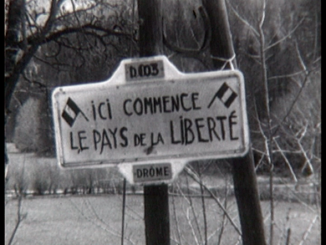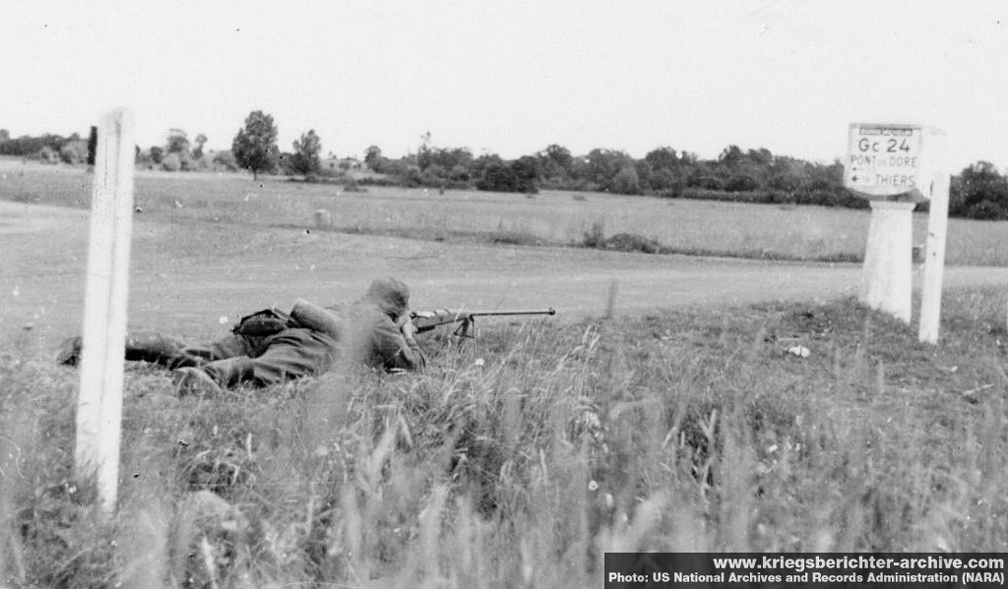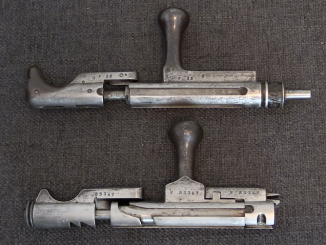Combination knife/gun weapons have been popular gadgets for literally hundreds of years, and this is one of the nicest examples I have yet seen. This sort of thing is usually very flimsy, and not particularly well made. This one, however, has a blade which locks in place securely and would seem to be quite practical. The firearm part is also unique, in that it uses a needle fire bolt action mechanism. This is a tiny copy of the French military Chassepot system, complete with intact needle and obturator.
And, of course, since it is French the trigger is a corkscrew.




It would seem to be the sort of thing an elegant boulevardier would carry in his pocket if he anticipated being accosted by Apaches (the French kind, not the Native American sort) with their Dolne or Delhaxhe pinfire pepperboxes. The bore looks to be about 7mm (.276″), which was typical for French pocket pistols of its day.
The corkscrew is a typical trigger setup for a combination pocketknife/gun. And of course, no gentleman would be without his corkscrew, especially at lunch.
The double-edged dagger blade is a bit unusual, as most pocketknife pistols had more conventional single-edged blades. As for its sharpness, you wouldn’t want it too sharp, or you’d slice your fingertips trying to open it. I’m tempted to suspect that this one may originally have been a “switchblade”, i.e. the blade was snapped open by a leaf spring, probably when the trigger was pulled. Many such knives have had their opening springs disabled or removed over the years, due to the U.S. laws regarding “automatic opening” knives.
BTW, for those who don’t know, the Chassepot needle-fire system worked a little differently from the original Dreyse. In the Dreyse, the primer was attached to the back end of the bullet itself, requiring a long firing needle that completely pierced the black powder charge to set it off. This exposed the needle to severe heating and corrosion, causing it to break fairly often in use. Prussian soldiers carried spare needles and learned to change them quickly, even under fire, for this reason.
The Chassepot system placed the primer inside the back end of its paper cartridge, as Ian stated. So all its needle had to do was pierce the cartridge paper to set off the primer. The result was a much shorter, sturdier “firing pin”, the first such centerfire pin in history.
In many respects, the Chassepot was a forerunner of the early “balloon head” metallic cartridge with its inside primer held in place by a “battery disc” against the inside of the case head. If not for the cannelure just ahead of the rim, that holds this disc in place with the priming underneath it, a balloon head centerfire would be hard to distinguish from a rimfire.
cheers
eon
Fascinating piece! I would guess that the excellent condition is probably due to the lack of ammunition to fit it.
That is so stinkin’ cool! Love the wine opener on it, could be tricky if you were opening your third bottle of Vin Oridnaire and had you weren’t the only thing loaded.
Could be messy.
I thought you emptied the chamber prior to opening a bottle. Just remember to get a cleaning rod for the purpose. I could be wrong.
Yes, one of the small problems with a needle gun, either Chassepot or Dreyse-type persuasion, was that in event of a dud primer, a cleaning rod applied from the muzzle end was the only way to get the round out of the chamber.
Still, in a pistol it had to be at least a bit easier; not so much barrel to contend with.
cheers
eon
It’s a bit of a nuisance, indeed. Modern primers don’t always go off when the Chassepot needle pierces them and so 5-10% of rounds are duds in my experience.
“Love the wine opener on it”
Cork-screw in fire-arm, wait a moment, I recall something similar, the bottle opener for Picatinny: http://www.urbanertslings.com/tbo-ace-tactical-bottle-opener-sling-attachment/
After the shooting and the knifing, the bottle of wine!
I think the knife was just there for serving the cheese.
Berthod, 39&41 Passage Jouffroy, turns up in the Annuaire-Almanach du commerce for e.g. 1878 as knife-makers, so I assume that this is a commercially available knife fitted by someone else onto the gun
http://gallica.bnf.fr/ark:/12148/bpt6k9692809v/f922.item.r=Berthod
Nice, a Chassepot salesman sample. Demonstrate it, get a deal and then open a good bottle to celebrate! Just kidding.
What a nice and well preserved piece.
Is there any record of one with a trigger that could be used to get a stone out of a horse’s hoof?
None that I know of, but the Peavey patent knife pistol had a hammer that probably could have served the purpose;
http://www.hansenguns.com/images/peaveyknife3.jpg
Here’s the actual patent;
http://patentimages.storage.googleapis.com/pages/US53473-0.png
It was originally a percussion muzzle-loader, but a later model used .22 rimfire.
cheers
eon
And how about this
http://www.ohgizmo.com/2008/07/17/english-patent-curiosa-railroad-pocket-watch-gun/
Oh yeah, it is English but still, what a nasty surprise!
There was an American version, too, patented by Leonard Woods of St. Louis, MO (not the U.S. Army general they named the fort after, apparently). It fired a standard .22 rimfire cartridge.
U.S. Patent 1,073,312- Pistol-September 16, 1913;
https://www.google.com/patents/US1073312
Quote;
The modern equivalent would be a pistol disguised as a cellphone;
http://www.hoax-slayer.com/images/cell-phone-gun-2.jpg
And now there really is a pistol that “sort of” qualifies;
https://www.idealconceal.com/
To me, it doesn’t look all that much like a phone, but then I’m strictly a landline sort of person.
cheers
eon
“U.S. Patent 1,073,312- Pistol-September 16, 1913;”
This reminded me about patent for gun build in… helmet, that is Patent US1183492A WEAPON from 1916:
https://www.google.com/patents/US1183492
illustration: http://www.weirduniverse.net/blog/comments/albert_bacon_pratts_helmet_gun/
additionally it could be used as cooking utensil
regarding recoil The blow-back causes the breechbolt to retreat and automatically cock the hammer, but the strong spring back of the breech-bolt forces the same so quickly forward again following the recoil, that the two movements naturalize one another so promptly that no discomfort to the wearer results from the recoil.
After quick search it seems that Albert B Pratt which patented helmet-gun also patent something possibly more useful, namely Patent US1191460A FIREARM from 1915
http://google.be/patents/US1191460
judging from drawing it seems to be so-called thumbhole stock
(that is over 100 year ago)
Ah, those French, masters of intrigue…..
reminds me of 1962 movie Arsene Lupin contre Arsene Lupin.
They are good at what they know the best – sudden turn of events.
https://www.youtube.com/watch?v=ZvMK9w-Gvms
🙂
“– sudden turn of events.’ should have been “sudden reversal”
Just like this pistol; you want to open wine and you guest does not like the vintage – well you have pistol to make him believe that the vintage is right. 🙂
I can explain the inscription at 5:20, “Passage Jouffroy”.
“Passage” means “pathway”. It is the name of the pedestrian only streets in France and, especially when talking about Paris, it refers to the “pasages couverts”, covered pathways, which are pathways with ceilings made of steel and glass.
They are made in such way that, walking on it, you are not inside a building but in an actual street (there is no door to open. Doors are present though and are closed during the night because nobody lives here, there is only shops and services) but have the benefit of protection against rain. They also are warmer than other streets, even though totally open (some, as Passage Jouffroy, have their own warming system).
Usually, they are populated by onlookers, artists and lovers walking around in some of the very last places of the romantic Paris. It is the places where you can find antique shops, artists shops, fancy or luxurious shops and bourgeois cafés and restaurants.
Passage Jouffroy is one of them and is in the 9th district of Paris. It is indeed a fancy place. If you come to Paris, you definitely need to walk on the passages couverts, because they are what foreign people usually think Paris is and what French people want Paris to be again (and is not anymore).
By the way, Ian, your French becomes more and more accurate. I’m impressed by your French “R”, which is very hard to get for an English speaker.
Why is the bolt handle on the right side? This is not a rifle, so presumably the shooter is holding the gun with the strong hand when reloading, which is probably the right hand. It would make more sense to configure the bolt handle on the left side.